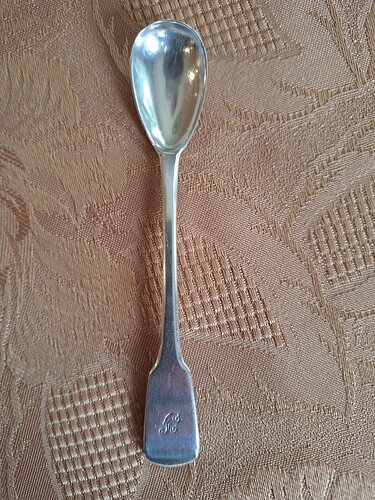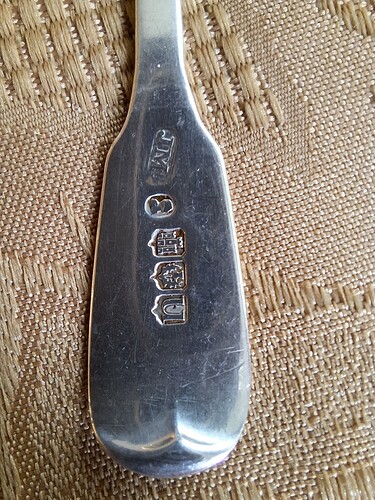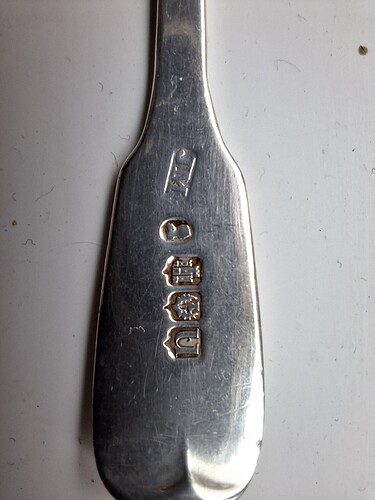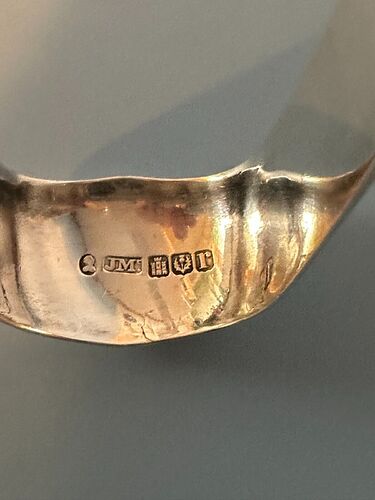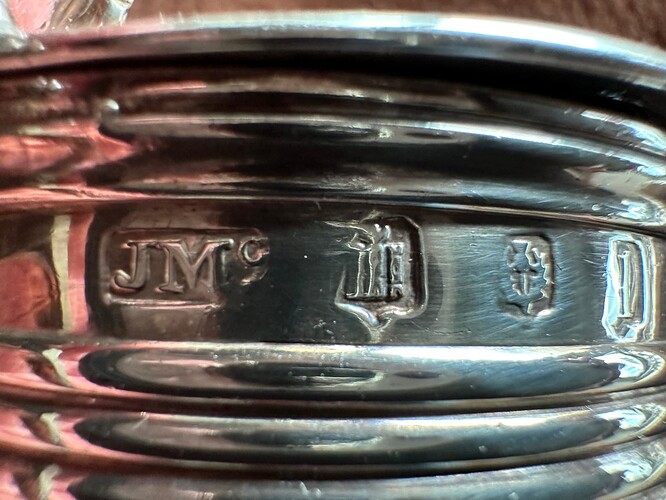Picked this up because i liked the crisp hallmarks. Edinburgh 1826, assumed it was Jonathan Millidge, but now I’m not so sure. The J doesn’t look right but the date matches up. Is that a small c after the M?
U r right - Jonathan Millidge, Edinburgh, 1826.
Dots JM⠨
https://www.silvermakersmarks.co.uk/Makers/Edinburgh-JG-JM.html#JM
Thanks for your response Bart. Interesting. The one you found in The Finial seems to have one dot, the one on the silver maker’s mark site has not dots, and I can’t tell if mine has one, two or none. I’ll go with Millidge on the grounds of probability. Is it possible he used all three marks? Thanks again
Paul, I’m not an expert. I examine and evaluate what I see.
Of course, and I appreciate your time and effort.
Exactly why Scots have to be so unimaginative in naming their children, especially if they are going to grow up to be silversmiths stamping repetitively similar initials on items that otherwise perfectly intelligent humans centuries later then rack their collective brains over for hours, I have no clue.
There are enough JM’s some of which are MacKays and all of which are James’ that the late 18th and early 19th century Edinburgh Guild records are stuffed to the gills with them.
Gills in this case being measures of whiskey rather than scuba apparatus for fish spared all this confusion.
However, since the topic is still open, I think Paul’s refusal to acknowledge the possibility of either colons or dots under absurdly small c’s, unless actually visible, is probably the way to go.
In case anybody thinks I am unfairly picking on Millidges and McKays, I have the same criticism of my own ancestors who also leaned heavily on James for a Christian name and McLeod for the second. The churchyard in Haddington, East Lothian is so full of them, there’s barely room for the odd John Knox descendant or the forebears of Robbie Burns’s including his mum and brother all of whom decided to mingle their bones with the
alphabetically-conservative McLeods and Bairds there. The situation is so bad that the owners of the Church, not god, the locals, decided to sell the entire scrabble set and the building complete with pews for 65,000 pounds.
God, as I understand it, has a vital but ancillary role in Scottish presbyterianism and unlike his Italian cousin doesn’t amass treasures on earth which saved him from the need to sell indulgences which, when sorting out Scots with names beginning with M don’t work as well as a gill of the usquebaugh no matter how many you attain.
CRWW
I drool at the thought that the 65 thousand quid may have included some sterling ecclesiastical goodies: communion chalices, offertory dishes, holy wine ewers, perhaps a tazza dish?
Hm. Despite the rotten reputation the 13th disciple gave silver, the church generally hangs on to it fairly enthusiastically although for some reason does not seem to be prepared to buy it back.
In Canada we are lumbered with a disproportionate amount of former ecclesiastical argent and it’s typically priced at scrap or marginally above. The only thing you can do to silver worse that adorning it with Jerusalem crosses or the like is engraving pictures of former human property on it. Even in the Carolinas that market is getting pretty thin.
One of family’s Baird forebears who didn’t manage to get back to East Lothian to get tucked in the old sod was a great uncle who for some reason not entirely explained joined the English church and went off to Flanders armed only with a Unite silver communion set. While he didn’t survive it did and turned up in some storage cupboard recently. I thought a rather pedestrian Victorian communion set stood out as something of interest if only for the hundreds of teeth marks of the dying taking both their last communion and gasp on the paten. The church disagreed.
I think there is an army chaplain’s memorial museum in the south of England. It might find it and the “mentioned in dispatches” material with Major Churchill’s signature of passing interest.
But there seems to be a plethora of Scottish Churches up for sale, sadly most with restrictive covenants rendering them redundant. Very different approach to superfluous church property in North America where if you made a decent offer for the church you can usually get the hosting small town thrown in as a job lot. There’s a list of them if you feel like trotting round some of them
CRWW
Well if the church won’t take your poor great uncle’s Unite communion set, I’ll be happy to take it off your hands. Along with Churchill’s signature. Though if we are talking about the same Churchill it would have been Lieutenant- Colonel Churchill who signed the dispatches as when he was a Major briefly, after the Dardenelles scandal, he didn’t have a command. Interestingly, while in command of a battalion of the Royal Scots Fusiliers on the front at “Plug Street” in Belgium, Lieutenant-Colonel Churchill’s sector was probably five miles from where the Bavarian Reserve Regiment was entrenched, and whose fighting strength included the later infamous Corporal Hitler.
James McKay Edinburgh.
I believe that’s correct. That appears to be a little “c” at the upper right of the maker’s mark. I’ve got a little McKay mustard pot from 1817 with the same mark, albeit somewhat rubbed.
ETA: Mind you, there’s no telling which James McKay it is. There are several listed, only the last of which used a mark that looks like this. The earlier McKays have no marks listed in the records of the assay office, so one can only speculate a bit. ![]()
Thank you, I think that might be it.
Also wanted to ask, does the lack of a journeyman’s mark suggest that Mr McKay (whichever one it was) made it himself? Where the stem meets the terminal looks a little wonky. Thanks again for all your input.
Not all workshops used journeyman’s marks so we can’t draw any conclusions about the actual maker.
Good to know, thank you
